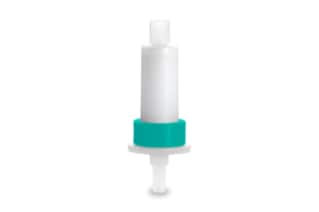
|
UNSPSC |
41115712 |
|
Brand |
Sep-Pak |
|
Product Type |
Solid Phase Extraction |
|
Units per Package |
50 pk |
|
Chemistry |
Alumina A |
|
Format |
Plus Long Cartridge |
|
Mass Spec Compatibility |
Yes |
|
Mode |
Normal-phase |
|
Particle Size |
50 - 300 µm |
|
Pore Size |
120 Å |
|
Sorbent Substrate |
Alumina |
|
Sorbent Weight |
1710 mg |
|
Water Wettable |
Yes |
|
pH Range Min |
0 pH |
|
pH Range Max |
10 pH |
|
Hold up volume |
1.2 mL |

Sep-Pak Alumina A Plus Long Cartridge, 1710 mg Sorbent per Cartridge, 50 - 300 µm, 50/pk
Alumina A Plus Sep-Pak The highly active grade of alumina in long cartridges has an acidic surface chemistry. The aluminum oxide surface possesses the characteristics of a Lewis acid and offers an exceptionally polar surface for analyte retention. In terms of application, this normal-phase sorbent is comparable to silica; however, it is somewhat more stable than silica that has not been functionalized at high pH levels. In aqueous conditions, this acidic alumina also functions as a low-capacity ion exchanger.
The Sep-Pak Alumina A Plus Long Cartridge's acidic alumina exhibits particular pi-electron interactions with aromatic compounds. This sorbent can be utilized for radioactive compound isolation and is unaffected by high-energy radioactivity, unlike polymer-based ion exchangers. These adaptable cartridges are simple to attach to pumps and syringes for dependable, positive-pressure flow to shorten the processing time for samples. They can also be utilized on vacuum-assisted flow devices and some automated systems, and they can be fitted with replaceable reservoirs.
We advise buying it directly from Waters to make sure you get real lab supplies. You can learn about the most recent technical developments and the equipment that is available by browsing our extensive catalog or going to our website to shop for lab equipment to meet all of your lab needs.
You might also be interested in reviewing the Waters Preparative Chromatography Mix Standard; Prior to analyzing critical material, users can benchmark and assess their chromatography system using the portfolio of Quality Control Reference Materials, which is a unique collection of standards and mixes. To verify the benchmark performance of your preparative or purifying system, utilize this standard mixture of diclofenac sodium salt, diphenhydramine hydrochloride, and flavone in DMSO. This QC Reference Material is a carefully formulated blend of neutral, acidic, and basic components, as well as a void marker. It operates with a variety of hardware configurations, sizes, and column chemistries.
How Do I Proceed If My Chromatography Appears to Have Changed?
The two most frequent reasons for chromatography to change are when anything is trapped in the column and needs to be washed out or when your column is degrading because of your solution. By carefully monitoring and modifying the solution pH and pressure with a silica column in the system, you may help prevent degradation. We suggest washing with solvents that have the same polarity as the column to get rid of bound organics. Please remember that the majority of pollutants from the ion-exchange columns would be removed by a high-concentration salt washout.